
The sea cucumber is found throughout the world’s oceans. The sea cucumber belongs to a group of animals called echinoderms. Their closest relatives happen to be starfish as well as sea urchins. There are over 1,200 known species of sea cucumber! Sea cumbers are touted as having medicinal properties and are used as an aphrodisiac.
First the Stats…
Scientific Name: Holothuroidea
Length: Up to 6.5 ft
Lifespan: Up to 10 years
Now on to the Facts!
1.) The cucumber has a mouth at one end and they eliminate waste from the other end. When they begin life they are separated into 2 halves.
2.) A sea cucumber moves via a series of water filled tubes, or feet. They can have up to 2,000 of these feet! The ends of these feet are very sticky.
3.) Sea cucumbers ‘talk’ via the emission of chemicals released into the water that are picked up by other cucumbers in the area.
4.) During mating, a sea cucumber will send out sperm while the female will send out eggs. The two products meet to begin the new process of life.
5.) Sea cucumbers are protandrous hermaphrodites. This means that they can change from male to female, if needed!
But wait, there’s more on the sea cucumber!
6.) When faced with danger, some sea cucumbers can discharge sticky strands of mucus to entangle their predators. Other cucumbers can desecrate their own bodies by forcefully contracting their muscles and spitting out some of their internal organs from their anus. The missing body parts are regenerated. Some also produce holothurin, a toxin lethal to many fish.
7.) Pearl fish love to hide in the anus of the sea cucumber. They do so for protection from predation and sometimes use the waste as a food source.
Did you know…?
Like politicians, sea cucumbers have no brains that we can tell. Just a complex nervous system that uses their feet and skin to detect their environment!
8.) The sea cucumber can breed asexually. Asexual reproduction is a type of reproduction by which offspring arise from a single organism, and inherit the genes of that parent only
9.) Cucumbers feed on plankton, algae, and decaying matter, using tentacles surrounding their mouth to scoop up bits of food and stuffing it into their open mouths.
10.) Sea cucumbers are nocturnal (active at night).
Now a Short Sea Cucumber Video!
Also, check out the Critter Science YouTube channel. Videos added frequently!
Want to suggest a critter for me to write about? Let me know here.



